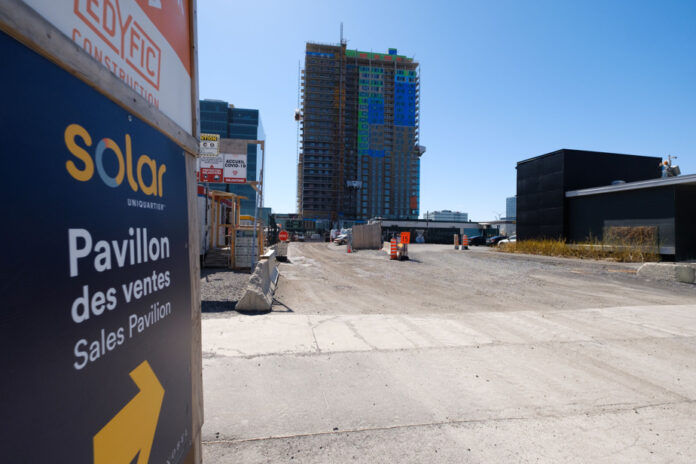In recent years, cities, in search of new revenue, have increased bills to developers, who then pass them on to consumers. They end up paying more for their roof.
The municipal world is not the only culprit. The Société de transport de Montréal (STM) and the Autorité régional de transport métropolitain (ARTM) both want the imposition of a fee on construction around the new stations of the metro blue line in eastern Montreal, like what the Réseau express métropolitain (REM) obtained.
The Urban Development Institute of Quebec (IDU), a lobby for real estate developers, opposes these fees. To support his position, he calculated the cumulative impact of all the fees imposed by local authorities on the cost of housing.
The various bills have a cumulative effect: the owner of a new condo with an area of 75 square meters (800 square feet) finds himself paying $34,000 more for his condo because of development charges and other fees. imposed on promoters.
The IDU took the example of the construction of a building of 250 housing units spread over 10 floors and 2 floors of underground parking built near a REM station. In the first case, the building is erected in Brossard; in the second, in the borough of Saint-Laurent, in Montreal.
The list of fees includes the REM fee equivalent to $122/m² of floor space, the Brossard development fee of $3,500 per unit, the Regulation for a mixed metropolis, applicable to Saint-Laurent, but not to Brossard, the fees for park equivalent to 10% of the value of the land and the costs linked to compliance with zoning regulations (particular construction project, modification or occupation of a building or even an implementation and architectural integration plan ) and the issuance of permits.
All of the fees increase the sale price of a condo by $34,000 in Brossard and by more than $36,000 in Saint-Laurent. The sale price of the condo is estimated at $551,000 in Brossard and $560,000 in the Montreal borough.
The main difference between the two sectors is the presence of the diversity regulation in force in Montreal which imposes a penalty on developers who do not integrate social or affordable housing into their project.
Such a regulation has no equivalent in Brossard. In contrast, the South Shore city recently imposed a development fee of $3,500 per unit.
By far, the largest fee is the REM fee, which comes to $14,000 per unit.
The IDU has not calculated the impact on rent in the case of rental accommodation, which is also subject to various royalties and development costs.
For the builder, royalties and other fees add up to a total bill of between 6.5 and 7.4 million, or about 9 to 10 percent of total costs. Depending on market conditions and financing, part of the costs may be absorbed by the developer, which explains the difference between the 10% from the developer and the 6% absorbed by the end user.
Sainte-Catherine Street is showing resilience after fearing the worst for its merchants during the pandemic.
Key signals of commercial vitality are pointing in the right direction, even if everything has not returned to pre-pandemic levels, underlines the annual study by real estate agency JLL on commercial properties in Canada.
Retail sales grew 7% in the first quarter of the year in Montreal, compared to 5.8% for the province. Sales of shoes and clothing stood out in Montreal with an annual increase of 14.8% and 11% respectively, in the first quarter of 2023.
The study also measured the increase in pedestrian traffic at three intersections on Sainte-Catherine Street, at the corner of Guy, Crescent and Peel streets. In total, traffic grew by 127% in two years, between the first quarter of 2021 and the first quarter of 2023.
Another revealing statistic, the vacancy rate of stores on Sainte-Catherine Street has fallen by 2 percentage points in one year. But at 22% in May 2023, the rate is very high and remains well above the situation before the pandemic.
Note that the Altus group of real estate services experts had a significantly lower figure, at 16% instead of 22%, during the same period. Methodological differences explain the discrepancy. “For our part, we were looking at Sainte-Catherine d’Atwater in Papineau,” says Jean-François Grenier, senior director at Groupe Altus.
The historical average for the vacancy rate is 7% on Sainte-Catherine Street, according to Altus.
On the side of the Société de développement commercial (SDC) Montréal centre-ville, we emphasize that the rate for the renovated section of rue Sainte-Catherine (from Mansfield to De Bleury) is half as high as that of the part whose work remain to be done, mentions Emmanuelle Allaire, press relations manager.
On this stretch, one in two businesses is linked to the fashion, clothing and shoes sector, and one in ten is occupied by a restaurant or bar.
“Since 2019, the number of fashion boutique operators has been growing on Rue Sainte-Catherine,” observes JLL, “which bodes well, because these categories have been more successful in recent years with the gradual return of workers to the office. »
Among the notable departures from Montreal’s main commercial street are American Eagle Outfitters, Banana Republic, Lolë and Videotron. Noteworthy arrivals include Influence U, Olam and Nike. For its part, La Cordée opened a 2,330 square meter store in the underground gallery of Promenades de la Cathédrale.
Speaking of underground Montreal, occupancy is significantly increasing in shopping malls, despite a vacancy rate of 12%.
For the future, the study identifies entertainment and pop-up stores as growth vectors for Sainte-Catherine.
“Already recognized as a hotspot for entertainment, Sainte-Catherine Street will benefit from new concepts that will meet the needs of residents of recent downtown residential towers, office workers, tourists and students. Recently opened, the REM, which serves the downtown core, will attract consumers who would otherwise have decided to stay in the suburbs,” says Jesse Prevost, associate vice president at JLL retail.















